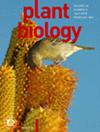葡萄细胞对生理剂量乙醇的反应,包括诱导对热应激的抗性。
IF 3.6
3区 生物学
Q1 PLANT SCIENCES
引用次数: 0
摘要
葡萄藤自然会受到高温、干旱和缺氧等压力的影响。最近的一项研究发现,葡萄浆果中的氧气含量很低,这与乙醇含量有关。其他的研究已经证实了乙醇和对各种压力的耐受性之间的联系:热、干旱和高盐度。造成这种偏差的原因尚不清楚。在我们的研究中,对3周龄Gamay愈伤组织,Vitis vinifera进行了内源氧和乙醇浓度的表征。我们进行了一项全球转录组学研究,以探索葡萄细胞对乙醇的反应,据我们所知,这是第一次在植物中进行这样的分析。1 mM乙醇处理后6和24 h对细胞进行RNA-seq分析。6 h后,乙醇导致386个差异表达基因(deg),与热反应相关的基因显著上调,尤其是小热休克蛋白(sHSPs)。进一步的实验表明,在葡萄细胞和拟南芥幼苗中,乙醇分别减少了热胁迫下色素和电解质的泄漏。这项研究支持了乙醇启动有助于保护植物免受热胁迫的观点,并为进一步研究潜在机制提供了有价值的RNA-seq数据集,其中sHSPs在这种适应性反应中发挥了潜在的关键作用。本文章由计算机程序翻译,如有差异,请以英文原文为准。

Responses of grapevine cells to physiological doses of ethanol, including induced resistance to heat stress
求助全文
通过发布文献求助,成功后即可免费获取论文全文。
去求助
来源期刊

Plant Biology
生物-植物科学
CiteScore
8.20
自引率
2.60%
发文量
109
审稿时长
3 months
期刊介绍:
Plant Biology is an international journal of broad scope bringing together the different subdisciplines, such as physiology, molecular biology, cell biology, development, genetics, systematics, ecology, evolution, ecophysiology, plant-microbe interactions, and mycology.
Plant Biology publishes original problem-oriented full-length research papers, short research papers, and review articles. Discussion of hot topics and provocative opinion articles are published under the heading Acute Views. From a multidisciplinary perspective, Plant Biology will provide a platform for publication, information and debate, encompassing all areas which fall within the scope of plant science.
 求助内容:
求助内容: 应助结果提醒方式:
应助结果提醒方式:


